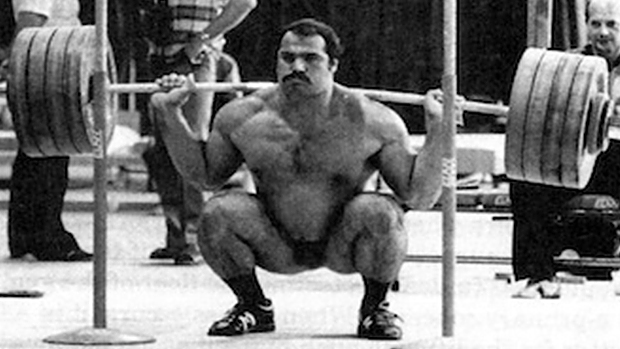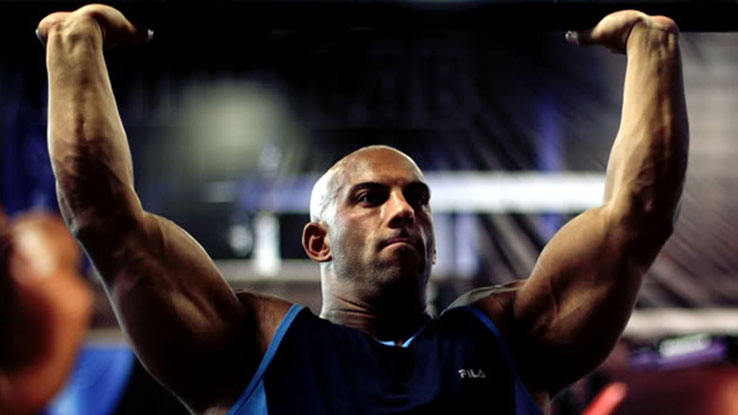The farmer's walk builds muscle ridiculously fast, slashes body fat, increases strength and performance in the big lifts, and has very little risk of injury.
A heavy farmer's walk will quickly fry your back, shoulders, and grip while making your lungs feel like you've guzzled a gallon of napalm.
The farmer's walk is the simplest exercise you can do. Just pick up some heavy weights, walk as far as you can and repeat.
I'd argue that a biggest reason they're not used more often is because they're too simple. Everyone wants the newest, hottest exercise, but that often means an easier movement. What they really need to do is get back to basics and man up.
The farmer's walk engages all the muscle groups in one movement. It's an exercise in pure strength. Here's the breakdown:
Arms
Your arms will scream as the weight relentlessly tries to separate your shoulders and elbows from their sockets. The forearms get an intense workout, which helps improve grip strength, while the biceps and triceps must work to stabilize the elbow and shoulder joints.
Back and Shoulders
The muscles in the back and shoulders are heavily targeted, particularly the traps. These muscles must work together in a continuous contraction to keep your shoulder blades together and down, and to keep your shoulder joints stable.
Core
Here's a way to get tighter, stronger abs without doing an ab-specific exercise. The core muscles are hit hard during a heavy farmer's walk, and the back and abdomen must work in sync to support your torso and the additional weight. Keeping your abs tight during the exercise is necessary to protect the lower back and prevent any shear stress or vertebral buckling.
Legs
Because the farmer's walk requires you to walk, the quadriceps, hamstrings, gluteus medius, gluteus minimus, and calf muscles are used extensively.
Usefulness
The farmer's walk trains your body in a way that's useful even beyond the gym. You can't underestimate the importance of grip strength and the ability to lift and carry heavy objects for health or in everyday life. The farmer's walk might be the most "functional" exercise in existence.
You can perform them with dedicated farmer's bars, or heavy dumbbells and kettlebells. You could even use water jugs, buckets of sand, trap-bars, or the Dead-Squat® Bar. It doesn't really matter, as long as it's heavy, safe, and poses a challenge.
Not much coaching is required beyond "grab some weight and start walking, pencil-neck." However, execution does depend on the equipment involved.
- Standard: Grab two heavy dumbbells, kettlebells, or farmer's bars and walk as far as you can. This will tear up your traps and forearms and generally make a man out of you.
- Single: Grab one heavy implement and walk as far as you can.
- Barbell: Deadlift a loaded bar and walk.
- Overhead Dumbbell: Grab two dumbbells, press them overhead to lockout, and walk with them overhead.
- Overhead Barbell: Clean a heavy loaded bar, press it overhead to lock-out, and walk with it overhead.
- Overhead Single Dumbbell: Carry one heavy dumbbell or kettlebell overhead, one arm at a time. This move is also known as a waiter's walk.
- Uneven Farmer's Walk: Carry two heavy dumbbells or kettlebells of different loads (different weights in each hand). Switch up the hands holding the heavy weight each workout.
- Dinosaur: Pick up any awkward heavy object and carry it.
- Trap Bar: Stand inside a heavy trap-bar, grab the two handles and stand up, then walk as far as you can. At my gym we often use the Dead-Squat™ Bar for farmer's walks.
The beauty of the farmer's walk is its simplicity. You can add it to any training program and make the program better. I'll do some version of a loaded carry at the end of every strength training workout.
Here's an example of how they could be built into a program:
- Day 1 – Push Day. Add one set of standard farmer's walks.
- Day 2 – Pull Day. Add one set of single-arm farmer's walks.
- Day 3 – Leg Day. Add one set of uneven farmer's walks, a different weight in each hand.
The goal every week is to increase load or duration of the set.
- Week 1 – Walk 25 feet up and back 3 times
- Week 2 – Walk 30 feet up and back 3 times
- Week 3 – Increase the weight and walk 25 feet
- Week 4 – Walk 30 feet with the heavier weight
Be sure to note your numbers and your distance and try to improve on it weekly.
Every week I rotate the type of farmer's carry, alternating from handles to kettlebells to fat-grip dumbbells. Training variety is endless. However, the key to success in the farmer's walk is not in the walking, but how you walk with the weight.
Everything starts with posture.
The temptation during the farmer's walk is to adopt a head forward/rounded shoulder posture, but performing the exercise this way places considerable stress on the neck, upper body, and joints. To make the move safer and more challenging, it's important to work on improved positioning, even if maintaining a tall spine comes at the price of additional weight.
You don't want to reinforce a slumped posture with a pair of heavy weights dragging you down on either side. Better to work with a conservative load and learn to control the downward gravitational pressure and build to a more substantial weight from there.
The biggest decision you have to make is whether your emphasis is on distance or weight.
Start with a light weight and master the tall spine. There are also distinct benefits to lifting lighter weight. A longer duration with lighter weights (a challenging load you can walk with for two minutes) can have a similar effect on your cardiovascular system as a series of sprints while working on a completely different neural and loading demand.
Furthermore, just like all interval training, you're setting your body up for an epic after-burn. Keeping it lighter and aiming for longer distance will ramp up fat loss. This also makes it a fantastic finisher.
On the other hand, keeping it heavy and brief by slowly building the load turns this into a more strength-based, weight-bearing exercise. Your upper body will grow in relation to the weight you're carrying and your grip strength will go up drastically. Heavier weights will also help improve your other lifts.

This works wonders for getting a stronger core, reducing back pain, and making your body into an all-out machine.
When doing the farmer's walk you need to lock in and brace your core. You must maintain core stiffness throughout the walk and not lose it.
An easy way to remember this is to imagine someone is about to punch you in the stomach. Your immediate reaction is to clench up your stomach/core. This is bracing. Your core contracts and your ribs don't rise. From here, lock in your core and don't let it move. You want a full 360-degree brace around your entire core, not just the front area.
Proper breathing technique also makes a big difference. When you do your carries, imagine you're breathing through a straw.
As much as I hate straps in training for the beginning lifter, once you reach a certain weight on the farmer's walk the risks of going "strapless" outweigh the benefits.
I've found that the grip is always the first thing to go with very heavy carries. So unless you have the mitts of a 300-pound strongman, your grip will usually be the limiting factor.
Don't use straps to build general overall strength, but once you reach a point of training heavy (roughly 50% of your body weight per hand), the straps are needed and can actually help reduce injuries. It goes beyond tearing up your hands and risking extra calluses – using straps can also reduce the risk of tendonitis.
Done right, a farmer's walk can make you a hell of a lot of bigger, stronger, and leaner. Don't underestimate the impact of this brutal but basic exercise.





